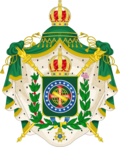
Back Lys van monarge van Brasilië Afrikaans Brasil Cāsere ANG إمبراطور البرازيل Arabic ملوك البرازيل ARZ Seznam brazilských panovníků Czech Brasiliens monarker Danish Μονάρχες της Βραζιλίας Greek Listo de monarkoj de Brazilo Esperanto Anexo:Monarcas de Brasil Spanish Brasiilia keiser Estonian
| Monarchy of Brazil | |
|---|---|
Imperial | |
 | |
 | |
| Details | |
| Style | His/Her Most Faithful Majesty His/Her Imperial Majesty |
| First monarch | Maria I (as queen) |
| Last monarch | Pedro II (as emperor) |
| Formation | 16 December 1815 |
| Abolition | 15 November 1889 |
| Pretender(s) | Disputed: Prince Bertrand (Vassouras Branch) Pedro Carlos Orléans-Braganza (Petrópolis Branch) |
The monarchs of Brazil (Portuguese: monarcas do Brasil) were the imperial heads of state and hereditary rulers of Brazil from the House of Braganza that reigned from the creation of the Brazilian monarchy in 1815 as a constituent kingdom of the United Kingdom of Portugal, Brazil and the Algarves until the republican coup d'état that overthrew the Empire of Brazil in 1889.[1]
The coast of the territory which would become known as Brazil was first explored by Portuguese navigators on 22 April 1500. This territory was subsequently colonized by the Portuguese crown. Since the transfer of the Portuguese court to Brazil in 1808, colonial rule had de facto ended. On 16 December 1815, Prince Regent John, the future king John VI, raised Brazil to the status of a kingdom, thus making his mother, Maria I, the reigning queen, the first monarch of Brazil. The next year, 20 March 1816, John succeeded his mother as king of the united Luso-Brazilian monarchy. Having proclaimed independence of the Kingdom of Brazil from Portugal in 1822, Pedro I, son of John VI, was acclaimed the first emperor of Brazil on 12 October 1822. He was later succeeded on 7 April 1831 by his son Pedro II, deposed along with the 74-years-old monarchy on 15 November 1889 in a bloodless and unpopular military coup d'état.
- ^ Bandeira, Moniz. Casa da Torre de Garcia d'Avila. Editora Record, 2000, pp. 423–425